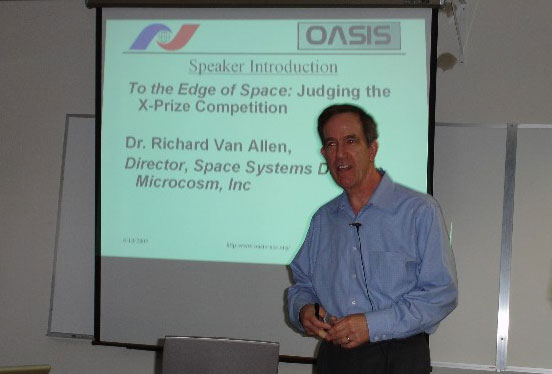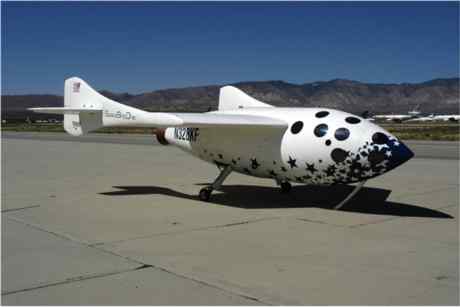Search this Site







To the Edge of Space: Judging the X-Prize
By Robert Gounley
In an airplane hangar at Mojave Airport, Brian Binnie waited impatiently for his weigh-in. He wasn’t going into a boxing ring or riding a thoroughbred, but something no less dangerous. Brian was about to pilot the third flight of SpaceShipOne and the second of two required flights to win the X-Prize competition. If successful, the flight would earn Burt Rutan and his Scaled Composites rocket team the X-Prize by demonstrating a sub-orbital spacecraft that could carry passengers. At stake was $10,000,000 in prize money and the publicity needed to build a space tourism industry.
 |
| Dr. Richard Van Allen shares stories from his X-Prize judging experience with OASIS members. Photo by Seth Potter |
The prize set strict rules. Two spacecraft, no more than two weeks apart, must carry three people weighing at least 90 kg or the equivalent weight in ballast. Like its first test flight and the first official flight for the prize, SpaceShipOne would carry only a pilot. Brian was about to be weighed in front of the X-Prize judges to be sure his craft flew enough ballast to qualify.
Brian’s family was there to wish him well. During the wait, his mother-in-law gave Brian a final “good luck” hug. Brian stiffened. Brian’s mother-in-law had been sipping a cup of coffee. During the embrace, her hand slipped, spilling coffee down the back of Brian’s flight suit.
There wasn’t time to change suits. Brian continued with the weigh-in and went on to fly SpaceShipOne into space and into the record books. So far, no coffee company has stepped forward to claim their place in space history.
X-Prize judge Dr. Richard Van Allen shared this story and many others during his June lecture for OASIS. He explained to an enthralled audience how his presence for the first flight by Mike Melvill was complete serendipity. He was originally scheduled to judge the first flight of another X-Prize competitor, the DaVinci Project. For its launch, the DaVinci rocket was to be hoisted to high-altitude by a balloon ascending from a remote corner of Saskatchewan. With the only airports far from the launch site, judges had to travel long distances over rough roads. However, Dr. Van Allen ended up having a conflict that prevented him from traveling to Canada, which later became a non-issue since the DaVinci team ran into problems and delayed their attempt indefinitely.
When Dr. Van Allen called his friend and Chief X-Prize judge Rick Searfoss—former Air Force Colonel and Space Shuttle Commander—to tell him he couldn’t go to Canada, it turned out that Searfoss needed a favor. Unexpectedly, he would be unavailable for the first SpaceShipOne launch. Could Van Allen step in to be judge at Mojave in his place? It was an easy decision.
 |
| SpaceShipOne, the X-Prize winning spacecraft. Photo Scaled Composites." |
Van Allen inspected the Scaled Composites entry. The transport plane, White Knight, carries broad sweeping wings in the style that made Burt Rutan famous. SpaceShipOne is a small rocket with stubby wings and a windowed cabin providing excellent views from every angle. In every aspect, their design emphasized simplicity and reliability over elaborate technology. The twin craft were pushed (the ultimate in low technology!) by a team of ten people to the runway, rather than trying to move the connected craft with a tow. Once in space, SpaceShipOne controlled attitude using compressed air instead of rockets. It landed without a heavy nose wheel—before it touches down, a thick wooden strut extends to drag along the runway like a matchstick. (No tires to deflate, no brakes to fail; it did the job with the fewest parts imaginable.)
SpaceShipOne’s chief financier, billionaire Paul Allen, had flown into Mojave to witness the historic event. There was a momentary delay to move his private plane out of the way for White Knight’s rollout.
X-Prize judges and assorted VIPs watched the launch from a small control room. Once aloft, White Knight and SpaceShipOne soon became very difficult to see with the naked eye. Most people turned away from the room’s windows to look at live television images broadcast from cameras mounted on the two craft.* Burt Rutan stood beside Paul Allen and Alex Tai, a 747 pilot for Virgin Atlantic who was now in charge of Virgin Galactic, the company formed by Richard Branson to fly space tourism flights.
SpaceShipOne’s launch was a success, and Burt Rutan’s team captured the X-Prize. Spaceflight begins a new phase, with private citizens soon to be able to experience the wonder and excitement of space travel for themselves. Perhaps with an eye towards history, the second flight took place on October 4, 2004—the 47th anniversary of Sputnik’s launch.
OASIS is grateful to Dr. Van Allen for giving us a firsthand account of a new space milestone.
*Ecliptic Technologies of Pasadena, CA provided the cameras. Its President, Rex Ridenoure, spoke to OASIS in 2002.
Copyright © 1998-2007 Organization for the Advancement of Space Industrialization and Settlement. All Rights Reserved.